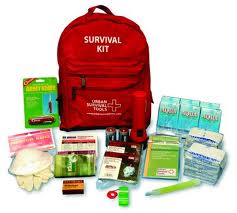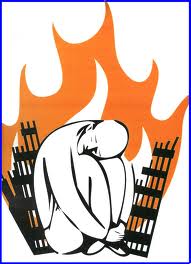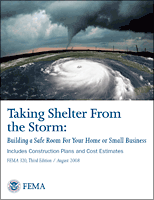|
Disaster Recovery To-Do List
Update Key Contacts - It is important to maintain up-to-date contact information for all employees, customers and vendors including their names, titles, recovery responsibilities, street address, mailing address, all phone numbers, a friend or relative's contact information, and email addresses. Then, keep this information offsite so if you need to access the information quickly you may do so. If you are a member of Agility you may use your myAgility account to store and update this information.
Emergency Contact List
Develop an Evacuation Plan - Share your plan and meeting place with employees and post it around the building. Schedule a drill so all employees know exactly where to go and what is expected of them.
Evacuation Tips
Make an Emergency Kit –  You may have to evacuate at a moment’s notice and most likely will not have time to search for the supplies you need. A disaster supply kit is simply a collection of basic items you may need in the event of an emergency. Click here for a complete list of things to include in your kit. You may have to evacuate at a moment’s notice and most likely will not have time to search for the supplies you need. A disaster supply kit is simply a collection of basic items you may need in the event of an emergency. Click here for a complete list of things to include in your kit.
Adult Check List
Kids Check List
Back up your Data - Backing up your data is an important task you need to perform on a regular basis. Also, remember to store your data in an offsite data storage facility. There are many offsite storage solutions available. Take a few minutes online and find the best solution for you.
Data Backup by EMC
Make Copies of Important Documents - This includes insurance papers, contracts, tax documents, etc. Scan them into the computer and then store  them offsite. Again, if an Agility member you may use your myAgility account to store this information. them offsite. Again, if an Agility member you may use your myAgility account to store this information.
Delegate Responsibility – Every disaster recovery plan should have a list of 'who is responsible to do what tasks.' For example, someone needs to be assigned with the following: securing the existing site, finding a new work site if necessary, arranging for new computer systems, retrieving the backup data, restoring telephone and fax service.... the list goes on. It needs to be decided who will do what. Luckily if you are a member of Agility, you just need to delegate someone to call us and we will take care of the rest.
|
Coping with Trauma After Violence and Disasters
Disasters cause major damage. Hurricanes Katrina and Rita were examples. They occurred in 2005. Many homes were destroyed. Whole communities were damaged. Many survivors were displaced. There were also many deaths.

Trauma is also caused by major acts of violence. The September 11, 2001 terrorist attacks were examples. Another example was the 1999 shootings at Columbine High School in Colorado. The Oklahoma City bombing in 1995 was also an example. These acts claim lives. They also threaten our sense of security.
Beyond these events, children face many other traumas. Each year, young people are injured. They see others harmed by violence. They suffer sexual abuse. They lose loved ones. Or, they witness other tragic events.
Children are very sensitive. They struggle to make sense of trauma. They also respond differently to traumas. They may have emotional reactions. Young survivors of trauma may need extra support. Teachers, religious leaders and other adult helpers can provide effective support.
Helping Young Trauma Survivors
The increased stress associated with disruptions in families; challenges in meeting daily needs such as food, water, and shelter; as well as disruptions in health and law enforcement services can increase the possibility of violence. Strategies for preventing violence after disasters should focus on providing assistance to individuals in need and developing supportive networks for managing daily tasks.Helping children begins at the scene of the event. It may need to continue for weeks or months.
Most children recover within a few weeks. Some need help longer. Grief (a deep emotional response to loss) may take months to resolve.
Children 6 to 11 years old may show extreme withdrawal, disruptive behavior, and/or inability to pay attention. Regressive behaviors, nightmares, sleep problems, irrational fears, irritability, refusal to attend school, outbursts of anger and fighting are also common in traumatized children of this age. Also the child may complain of stomachaches or other bodily symptoms that have no medical basis. Schoolwork often suffers. Depression, anxiety, feelings of guilt and emotional numbing or "flatness" are often present as well.
Adolescents 12 to 17 years old may exhibit responses similar to those of adults, including flashbacks, nightmares, emotional numbing, avoidance of any reminders of the traumatic event, depression, substance abuse, problems with peers, and anti-social behavior. Also common are withdrawal and isolation, physical complaints, suicidal thoughts, school avoidance, academic decline, sleep disturbances, and confusion. The adolescent may feel extreme guilt over his or her failure to prevent injury or loss of life, and may harbor revenge fantasies that interfere with recovery from the trauma.
Downloads
Trauma What Rescuers can do
Trauma What the Community can do
Trauma What Parents can do
Identify children who need the most support. Help them obtain it. Monitor their healing.
|
FEMA 320 - Taking Shelter From the Storm: Building a Safe Room For Your Home or Small Business
 Having a safe room in your home or small business can help provide "near-absolute protection" for you and your family or your employees from injury or death
caused by the dangerous forces of extreme winds. Near-absolute protection means that, based on our current knowledge of tornadoes and hurricanes, there is a very high probability that the occupants of a safe room built according to this guidance will avoid injury or death. A safe room can also relieve some of the anxiety created by the threat of an incoming tornado or hurricane. Our knowledge of tornadoes and hurricanes and their effects is based on substantial meteorological records as well as extensive investigation of damage to buildings from extreme winds. All information contained in this publication is applicable to safe rooms for use in homes as well as in small businesses. Having a safe room in your home or small business can help provide "near-absolute protection" for you and your family or your employees from injury or death
caused by the dangerous forces of extreme winds. Near-absolute protection means that, based on our current knowledge of tornadoes and hurricanes, there is a very high probability that the occupants of a safe room built according to this guidance will avoid injury or death. A safe room can also relieve some of the anxiety created by the threat of an incoming tornado or hurricane. Our knowledge of tornadoes and hurricanes and their effects is based on substantial meteorological records as well as extensive investigation of damage to buildings from extreme winds. All information contained in this publication is applicable to safe rooms for use in homes as well as in small businesses.
This publication will help you decide how best to provide near-absolute protection for yourself, your family, or employees and answers many questions concerning safe rooms. It includes the results of research that has been underway for more than 30 years, by Texas Tech University's Wind Science and Engineering (WISE; formerly known as the Wind Engineering Research Center or WERC) and other wind engineering research facilities, on the effects of extreme winds on buildings. Download the entire FEMA 320 document.
FEMA 320 also provides safe room designs that will show you and your builder/contractor how to construct a safe room for your home or small business. Design options include safe rooms located in the basement, in the garage, or in an interior room of a new home or small business building. Other options also provide guidance on how to construct an exterior safe room, either buried underground or attached to the existing building, or how to modify an existing home or small business building to add a safe room inside. These safe rooms are designed to provide near-absolute protection for you, your family, or employees from the extreme winds expected during tornadoes and hurricanes and from flying debris that tornadoes and hurricanes usually generate.
Why is the term "safe room" being used instead of "shelter"?
The terms "safe room" and "shelter" have been used, for the most part, interchangeably in past publications. Typically the difference in usage was limited to differentiating between residential applications called "safe rooms" and larger projects called "community shelters." The release of the ICC-500 standard, as well as other national, state, and local protection initiatives, identified a need to distinguish shelters that meet the FEMA criteria for near-absolute protection and those that do not. Although both the FEMA and ICC criteria are designed to provide life-safety protection for safe rooms and shelters that meet these criteria, only the FEMA criteria provides near-absolute protection from extreme wind events. To help clarify the difference between safe rooms design to FEMA 320 and FEMA 361 guidance, the term "safe room" applies to all shelters, buildings, or spaces designed to the FEMA criteria (whether for individuals, residences, small businesses, schools, or communities). This allows for the buildings, shelters, or spaces designed to the ICC-500 standard to be called shelters. All safe room criteria in the FEMA publications meet or exceed the shelter requirements of the ICC-500.
To order this or other publications please call 1-800-480-2520 or fax 1-240-699-0525 Monday through Friday 8 a.m. – 5 p.m. EST. You may also email your request to FEMA-Publications-Warehouse@dhs.gov. Please provide the title, item number, short number, and quantity of each publication, along with your name, address, zip code, and daytime telephone number.
|


 You may have to evacuate at a moment’s notice and most likely will not have time to search for the supplies you need. A disaster supply kit is simply a collection of basic items you may need in the event of an emergency. Click here for a complete list of things to include in your kit.
You may have to evacuate at a moment’s notice and most likely will not have time to search for the supplies you need. A disaster supply kit is simply a collection of basic items you may need in the event of an emergency. Click here for a complete list of things to include in your kit.
 them offsite. Again, if an Agility member you may use your myAgility account to store this information.
them offsite. Again, if an Agility member you may use your myAgility account to store this information.

 Having a safe room in your home or small business can help provide "near-absolute protection" for you and your family or your employees from injury or death
Having a safe room in your home or small business can help provide "near-absolute protection" for you and your family or your employees from injury or death